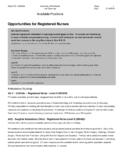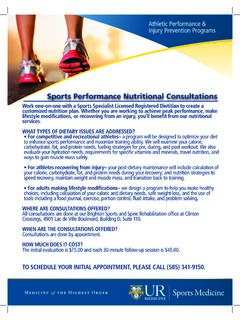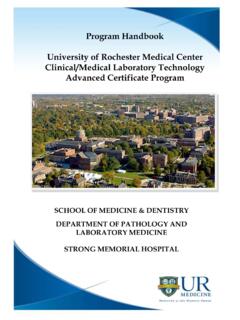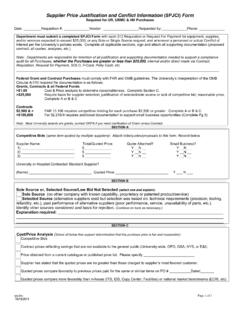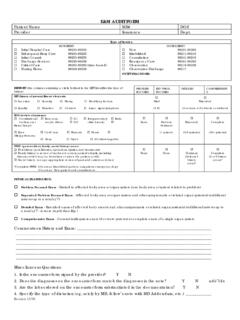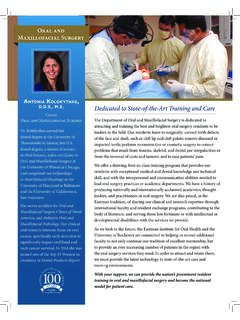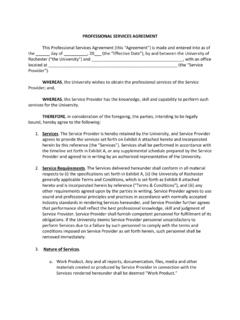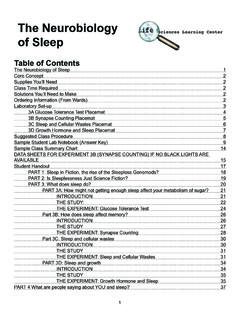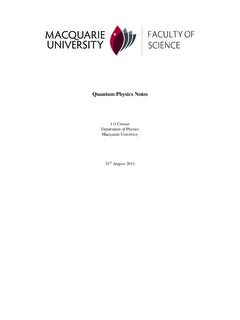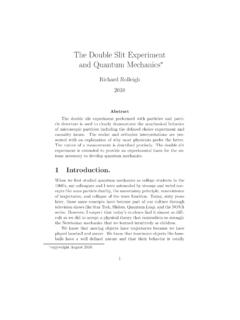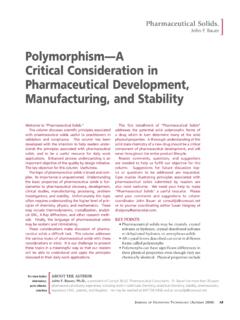Transcription of The Need for a New Medical Model: A Challenge for …
1 Psychodynamic Psychiatry, 40(3) 377 396, 2012 ENGELCLASSIC ARTICLE: A Challenge FOR BIOMEDICINECLASSIC ARTICLEThe Need for a New Medical Model: A Challenge for BiomedicineGeorge L. EngelAt a recent conference on psychiatric education, many psychiatrists seemed to be saying to medicine, Please take us back and we will never again deviate from the Medical model. For, as one critical psy-chiatrist put it, Psychiatry has become a hodgepodge of unscientific opinions, assorted philosophies and schools of thought, mixed meta-phors, role diffusion, propaganda, and politicking for mental health and other esoteric goals (1). In contrast, the rest of medicine appears neat and tidy. It has a firm base in the biological sciences, enormous technologic resources at its command, and a record of astonishing achievement in elucidating mechanisms of disease and devising new treatments. It would seem that psychiatry would do well to emulate its sister Medical disciplines by finally embracing once and for all the Medical model of disease.
2 But I do not accept such a premise. Rather, I contend that all medicine is in crisis and, further, that medicine s crisis derives from the same basic fault as psychiatry s, namely, adherence to a model of disease no longer adequate for the scientific tasks and social responsibilities of either medicine or psychiatry. The importance of how physicians conceptualize disease derives from how such con-cepts determine what are considered the proper boundaries of pro-fessional responsibility and how they influence attitudes toward and behavior with patients. Psychiatry s crisis revolves around the ques-tion of whether the categories of human distress with which it is con-cerned are properly considered disease as currently conceptualized and whether exercise of the traditional authority of the physician is Reprinted with permission. 1977 American Association for the Advancement of author is professor of psychiatry and medicine at the University of Rochester School of Medicine, Rochester, New York ENGEL appropriate for their helping functions.
3 Medicine s crisis stems from the logical inference that since disease is defined in terms of somatic parameters, physicians need not be concerned with psychosocial issues which lie outside medicine s responsibility and authority. At a recent Rockefeller Foundation seminar on the concept of health, one author-ity urged that medicine concentrate on the real diseases and not get lost in the psycho sociological underbrush. The physician should not be saddled with problems that have arisen from the abdication of the theologian and the philosopher. Another participant called for a dis-entanglement of the organic elements of disease from the psychosocial elements of human malfunction, arguing that medicine should deal with the former only (2). ThE TWO POsITIONsPsychiatrists have responded to their crisis by embracing two os-tensibly opposite positions. One would simply exclude psychiatry from the field of medicine, while the other would adhere strictly to the Medical model and limit psychiatry s field to behavioral disorders consequent to brain dysfunction.
4 The first is exemplified in the writings of Szasz and others who advance the position that mental illness is a myth since it does not conform with the accepted concept of disease (3). Supporters of this position advocate the removal of the functions now performed by psychiatry from the conceptual and professional ju-risdiction of medicine and their reallocation to a new discipline based on behavioral science. Henceforth medicine would be responsible for the treatment and cure of disease, while the new discipline would be concerned with the reeducation of people with problems of living. Implicit in this argument is the premise that while the Medical model constitutes a sound framework within which to understand and treat disease, it is not relevant to the behavioral and psychological prob-lems classically deemed the domain of psychiatry. Disorders directly ascribable to brain disorder would be taken care of by neurologists, while psychiatry as such would disappear as a Medical discipline.
5 The contrasting posture of strict adherence to the Medical model is carica-tured in Ludwig s view of the psychiatrist as physician (1). According to Ludwig, the Medical model premises that sufficient deviation from normal represents disease, that disease is due to known or unknown natural causes, and that elimination of these causes will result in cure or improvement in individual patients (Ludwig s italics). While ac-knowledging that most psychiatric diagnoses have a lower level of confirmation than most Medical diagnoses, he adds that they are not cLAssIc ARTIcLE: A Challenge FOR BIOMEDIcINE 379 qualitatively different provided that mental disease is assumed to arise largely from natural rather than metapsychological, interper-sonal or societal causes. Natural is defined as biological brain dys-functions, either biochemical or neurophysiological in nature. On the other hand, disorders such as problems of living, social adjustment reactions, character disorders, dependency syndromes, existential de-pressions, and various social deviancy conditions [would] be excluded from the concept of mental illness since these disorders arise in indi-viduals with presumably intact neurophysiological functioning and are produced primarily by psychosocial variables.
6 Such nonpsychiatric disorders are not properly the concern of the physician-psychiatrist and are more appropriately handled by nonmedical professionals. In sum, psychiatry struggles to clarify its status within the mainstream of medicine, if indeed it belongs in medicine at all. The criterion by which this question is supposed to be resolved rests on the degree to which the field of activity of psychiatry is deemed congruent with the existing Medical model of disease. But crucial to this problem is another, that of whether the contemporary model is, in fact, any longer adequate for medicine, much less for psychiatry. For if it is not, then perhaps the crisis of psychiatry is part and parcel of a larger crisis that has its roots in the model itself. Should that be the case, then it would be imprudent for psychiatry prematurely to abandon its models in favor of one that may also be BIOMEDIcAL MODELThe dominant model of disease today is biomedical, with molecular biology its basic scientific discipline.
7 It assumes disease to be fully ac-counted for by deviations from the norm of measurable biological (so-matic) variables. It leaves no room within its framework for the social, psychological, and behavioral dimensions of illness. The biomedical model not only requires that disease be dealt with as an entity inde-pendent of social behavior, it also demands that behavioral aberrations be explained on the basis of disordered somatic (biochemical or neu-rophysiological) processes. Thus the biomedical model embraces both reductionism, the philosophic view that complex phenomena are ulti-mately derived from a single primary principle, and mind-body dual-ism, the doctrine that separates the mental from the somatic. Here the reductionistic primary principle is physicalistic; that is, it assumes that the language of chemistry and physics will ultimately suffice to explain biological phenomena. From the reductionist viewpoint, the only con-ceptual tools available to characterize and experimental tools to study 380 ENGEL biological systems are physical in nature (4).
8 The biomedical model was devised by Medical scientists for the study of disease. As such it was a scientific model; that is, it involved a shared set of assumptions and rules of conduct based on the scientific method and constituted a blue-print for research. Not all models are scientific. Indeed, broadly defined, a model is nothing more than a belief system utilized to explain natural phenomena, to make sense out of what is puzzling or disturbing. The more socially disruptive or individually upsetting the phenomenon, the more pressing the need of humans to devise explanatory systems. Such efforts at explanation constitute devices for social adaptation. Disease par excellence exemplifies a category of natural phenomena urgently demanding explanation (5). As Fabrega has pointed out, disease in its generic sense is a linguistic term used to refer to a certain class of phenomena that members of all social groups, at all times in the history of man, have been exposed to.
9 When people of various intellectual and cultural persuasions use terms analogous to disease, they have in mind, among other things, that the phenomena in question involve a person-centered, harmful, and undesirable deviation or discontinu-ity .. associated with impairment or discomfort (5). Since the con-dition is not desired it gives rise to a need for corrective actions. The latter involve beliefs and explanations about disease as well as rules of conduct to rationalize treatment actions. These constitute socially adap-tive devices to resolve, for the individual as well as for the society in which the sick person lives, the crises and uncertainties surrounding disease (6). Such culturally derived belief systems about disease also constitute models, but they are not scientific models. These may be re-ferred to as popular or folk models. As efforts at social adaptation, they contrast with scientific models, which are primarily designed to pro-mote scientific investigation.
10 The historical fact we have to face is that in modern Western society biomedicine not only has provided a basis for the scientific study of disease, it has also become our own culturally specific perspective about disease, that is, our folk model. Indeed the biomedical model is now the dominant folk model of disease in the Western world (5, 6). In our culture the attitudes and belief systems of physicians are molded by this model long before they embark on their professional education, which in turn reinforces it without necessarily clarifying how its use for social adaptation contrasts with its use for sci-entific research. The biomedical model has thus become a cultural im-perative, its limitations easily overlooked. In brief, it has now acquired the status of dogma. In science, a model is revised or abandoned when it fails to account adequately for all the data. A dogma, on the other hand, requires that discrepant data be forced to fit the model or be excluded.
